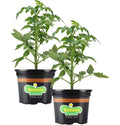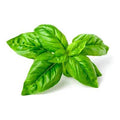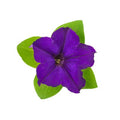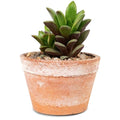Aspabroc Baby Broccoli (2 Pack)
2-pack starter plants
- Regular price
- $17.99
- Regular price
-
- Sale price
- $17.99
- Unit price
- / per
Read More
Read Less
Aspabroc Baby Broccoli (2 Pack)
- Regular price
- $17.99
- Regular price
-
- Sale price
- $17.99
- Unit price
- / per
Key Highlights
This variety is available at retailers only.
- LightPart to full sun
- Plant Height36 in
- Annual/PerennialAnnual
- ColorGreen
- Bloom PatternSpring
- SKU207802
Welcome to your plant
Remove Packaging
Take each individual bonnie plant out of the box before carefully opening each individual plant’s packaging. Be cautious of soil that may have shifted during transportation.
Check the Soil
Your plants were watered right before shipping, but they may have become thirsty during travel. If the soil is dry to the touch, give your plants a good drink before planting.
Adjustment Period
Let your plants get used to their new environment. Set them in a warm, sunny spot for 34 to 48 hours so they can recover from their trip before being planted.
Long Term Care
1. Location, location
Find the right spot for your plant. Check each plant’s tag for information on how much sun your plan’s need. Growing tip: if your plant needs full sun, a south-facing area will give you the most sunlight. If your plan can grow in part shade, an east or west-facing window might be enough.
2. Soil & drainage
Making sure your container has holes to allow excess water to drain is vital to your plant’s health! We recommend planting your Bonnie Plant in Miracle-Gro Potting Mix for containers, or Miracle-Gro Garden Soil for planting in ground.
3. Hungry plants
Feeding your plants is one of the best ways to improve your plant’s health and maximize your harvest. We recommend feeding with Miracle-Gro plant food when you transplant, and feeding regularly following label directions for best results.
Support
Can’t find the answer you’re looking for? Visit our FAQs or chat with our friendly team.
Where do my Bonnie Plants® come from?
Not far from where you are! We have over 70 growing stations spread across the country, so our plants don’t have to travel far to make it to your garden. That means less time spent in transit, which is better for the plants and for the planet, too. What’s more, each growing station grows varieties that tend to perform well in that particular region, so you don’t have to wonder whether the Bonnie veggies and herbs you buy are suitable for the area you live in.
Does Bonnie sell GMO plants?
No. Every plant we sell is grown from non-GMO seed.
How do I know if a plant is suitable to grow in my area?
Most of the vegetable and herb plants we sell on this site can be grown outdoors throughout the Continental US - however it is important to transplant your starter plant at the right time based on the weather and climate in your area.
Many of our herb plants can also be grown indoors so long as you have sufficient light and water. If you grow herbs indoors, you will still need to transplant your herb plants into properly sized containers with added potting mix.
What is a USDA Hardiness Zone?
The 2012 USDA Plant Hardiness Zone Map is the standard by which gardeners and growers can determine which plants are most likely to thrive at a location. The map is based on the average annual minimum winter temperature, divided into 10-degree F zones.
To learn more, visit https://planthardiness.ars.usda.gov/
How do I care for my plants once I receive them?
Your plant will come with both a care sheet and a plant tag, which gives you information on plant spacing, watering, sunlight and other important considerations to get you started.
Bonnie also has in-depth "How to Grow" guides available here.
How often do I need to water my plants?
A good rule of thumb is an inch of water per week, either by rain or watering; in arid climates, double that. In hot weather, vegetables need even more water, up to about a half an inch extra per week for every 10 degrees that the average temperature is above 60 degrees. You can measure an inch of water by putting a rain gauge or other container under your sprinkler, soaker, drip, or other watering system. You’ve applied an inch of water when the vessel collects water an inch deep. Container gardens may need to be watered more frequently than in-ground garden beds, so check the soil each day and add water if the top inch or so of potting soil is dry.
Related Products
Better Boy Tomato (2 Pack)
High yields of smooth skinned, large fruit earn Better Boy a spot as one of the most popular tomatoes grown in the US and as one of our all time best sellers. The fruit has excellent classic tomato flavor with just the right balance of acid and sugar. This is a great slicing tomato. It is widely adapted throughout the country. Grow it in a tall cage or tie to a stake for support. The indeterminate vines are resistant to verticillium wilt (V), fusarium wilt (F), and nematodes (N). Organic varieties are only available at retailers.
- Regular price
- $17.99
- Regular price
-
- Sale price
- $17.99
- Unit price
- / per
Sweet Green Bell Pepper (2 Pack)
Bonnie's best hybrid sweet bell pepper! A heavy yielder of large fruits. A good all-round pepper for slicing, stuffing, and freezing. This bell produces lots of fresh bell peppers gradually over the growing season. Plants in our Alabama garden produce from June through October, yielding 30 or more peppers from each plant. (Your results will vary based on care and the length of your growing season.) This is a good-sized plant, so be prepared to stake if needed. Organic varieties are only available at retailers.
- Regular price
- $17.99
- Regular price
-
- Sale price
- $17.99
- Unit price
- / per
Red Bell Pepper (2 Pack)
Sweet, juicy, nutritious red fruits add appetizing color to fresh salads and are superb for stuffing. Also great on the grill! The big, blocky peppers (they average around 4 to 6 Ounces) ripen from dark green to bright red. High-yielding plants are well adapted throughout the US. Grow your own and avoid premium prices at the grocery store. Organic varieties are only available at retailers.
- Regular price
- $17.99
- Regular price
-
- Sale price
- $17.99
- Unit price
- / per
Strawberries (2 Pack)
This everbearing strawberry produces high yields of large, very sweet fruit from late spring through fall. Large, soft, deliciously sweet fruit ideal for jam, preserves, fresh eating, or desserts. Plants are cold-hardy and send out long runners. Great for containers. Plant so that crown is just above soil level.
- Regular price
- $18.99
- Regular price
-
- Sale price
- $18.99
- Unit price
- / per
Best Seller
Beefsteak Red Tomato (2 Pack)
Beefsteaks are always grown for their flavor and size for slicing and summer sandwiches. This variety produces large, meaty red fruit over a long season on indeterminate plants. Because it matures late compared to many other tomatoes, it will provide a fresh harvest in the latter part of the season. This is an old favorite beloved by gardeners in the Northeast and grown throughout the country. Vigorous vines grow best in tall cages. Resistant to fusarium wilt (F) and nematodes (N).
- Regular price
- $17.99
- Regular price
-
- Sale price
- $17.99
- Unit price
- / per
Banana Sweet Pepper (2 Pack)
Named for its banana-like shape, this variety bears sweet, mild banana peppers that mature from yellow, to orange, and then to crimson red. Plants fruit prolifically, easily producing up to 25 to 30 pods per plant. Banana peppers are great for frying and pickling, and are an excellent choice for making pepper rings for sandwiches. Great for containers. Organic varieties are only available at retailers.
- Regular price
- $17.99
- Regular price
-
- Sale price
- $17.99
- Unit price
- / per
Italian Oregano (2 Pack)
Savor classic Italian cuisine with the flavorful leaves of this oregano. An easy-growing plant for the garden or container, Italian oregano hails from the Mediterranean region. That means it thrives with lower humidity and well-drained soil. In the garden, use this oregano as an edging plant. Plants spread when happy, rooting along the stems. Harvest leaves or stems anytime during the growing season. Flavor is most intense just before plants flower. Trim plants often to keep flower formation at bay.
- Regular price
- $18.99
- Regular price
-
- Sale price
- $18.99
- Unit price
- / per
Serrano Pepper (2 Pack)
This variety is a vigorous bearer of hot, pungent, candle-shaped fruits that mature from green to bright red. Plants do well in most climates and are especially well adapted to hot, humid areas. This pepper is growing in popularity for pickling and salsa, and is the pepper of choice for making pico de gallo.Organic varieties are only available at retailers.
- Regular price
- $17.99
- Regular price
-
- Sale price
- $17.99
- Unit price
- / per
German Queen Heirloom Tomato (2 Pack)
Heirloom. This old-fashioned beefsteak has large, sweet fruits that are lower in acid and quite meaty, making them perfect for slicing. The indeterminate vines will grow tall and bear fruit all summer long, so be sure to stake strongly or cage. One slice makes a great sandwich filling!
- Regular price
- $17.99
- Regular price
-
- Sale price
- $17.99
- Unit price
- / per
Spearmint Mint (2 Pack)
Spearmint has strong flavor and fragrance that is released with simple bruising. It's the best mint variety for hot and cold drinks. Toss bruised leaves into ice water for a refreshing summer drink or add to iced tea. Spearmint is favored for flavoring beverages such as mojito. Also know as Yerba Buena. Spreading plant is great for containers. Tolerates light frost.
- Regular price
- $18.99
- Regular price
-
- Sale price
- $18.99
- Unit price
- / per
Big Boy Tomato (2 Pack)
The name, Big Boy, is easy to remember and so is the flavor. This is a big, sandwich-type slicer with smooth, bright red fruit and a flavor that everybody likes. It bears heavily in mid-season, yet the indeterminate vines continue fruiting (though not as heavily) until frost. Plants in our Alabama test garden, where conditions are excellent, have yielded 100 tomatoes each through a 10-week harvest season. Long vines need staking, or grow the plant in a tall cage. Resistant to cracking.
- Regular price
- $17.99
- Regular price
-
- Sale price
- $17.99
- Unit price
- / per
Lieutenant Broccoli (2 Pack)
Well adapted to warm weather, these plants form smooth, dark green heads on medium-sized stems with few side shoots. Heads offer classic flavor and all the vitamins and protein broccoli is known for. Water plants consistently for best yields, especially as temperatures climb. If you like Packman, you’ll like Lieutenant Broccoli.
- Regular price
- $17.99
- Regular price
-
- Sale price
- $17.99
- Unit price
- / per
Lemon Balm (2 Pack)
Lemon balm, a member of the mint family, is a lovely mild herb named for the lemony scent of its leaves. Originally grown in South Europe, lemon balm is often used in combination with other herbs and is frequently found in poultry and fish dishes, desserts, and teas. It also makes a nicely scented sachet. Plant one at the edge of a gate so that when the gate opens and closes the lemony scent fill the air. Like other types of mint, it likes to spread, so a container is a great choice.
- Regular price
- $18.99
- Regular price
-
- Sale price
- $18.99
- Unit price
- / per
Curled Parsley (2 Pack)
Curled parsley has beautiful, dark green leaves well known as the classic garnish for deviled eggs and an ingredient in tabbouleh (parsley salad) or white clam sauce for pasta. However, it has many more uses. Hardy through zones 7 and warmer, it is a great winter garden plant and looks beautiful in containers with pansies or other winter color. The nutritious leaves are high in iron and in vitamins A, C, and E. The high chlorophyll content makes it a natural breath sweetener, too. Frost tolerant. Great in containers.
- Regular price
- $18.99
- Regular price
-
- Sale price
- $18.99
- Unit price
- / per
Red Romaine Lettuce (2 Pack)
This eye-catching romaine deserves a spot in both the vegetable and the flower garden. Colorful leaves start out green, then fade to a deep red-bronze as they mature. Red Romaine leaves bring a sweet, flavorful crunch to salads and sandwiches. The heads (if allowed to form) are thick enough to grill. Plants are slow to bolt and grow best in full sun, but will tolerate partial shade and even appreciate it in spring in hot climates. Resistant to mosaic virus.
- Regular price
- $17.99
- Regular price
-
- Sale price
- $17.99
- Unit price
- / per




 Herbs
Herbs
 Vegetables
Vegetables
 Fruit
Fruit
 Flowers
Flowers
 Succulents
Succulents

